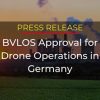If your heavy industry sites are devoting manpower, time, and resources to security, safety, O&M, and regulatory compliance, then you’re ready to take the leap and enter the era of autonomous drones. Unlike piloted drones, autonomous drones don’t rely on skilled pilots and are often safer and more versatile solutions. Autonomous drones promise precise and safe navigation while keeping operators firmly in control of granularly defining, scheduling, and monitoring the mission at hand. Similar to other autonomous technologies, autonomous drones markedly enhance the safety and efficiency of drone usage. All this translates to increased value – with an easily programable “eye in the sky” monitoring and securing assets and infrastructure.
Yet all autonomous drone solutions are not equal. Before you invest in an autonomous drone solution, ask yourself:
Does it fully automate data collection, processing and analysis?
Does it offer computer vision and AI?
Is it a multi-mission solution?
Is the system user friendly and easily configurable?
Does it allow for remote operations?
1. Does it fully automate data collection, processing and analysis?
An advanced autonomous drone solution should enable you to plan a mission once, then let the system fly it again and again, at intervals you define. Aerial data collected on each mission should be uploaded to a centralized repository, with processing and analysis conducted automatically. The end result should be constantly updated data assets – high-resolution maps, 2D/3D models, etc. – that require no human intervention to produce or update.
2. Does it offer computer vision and AI?
A drone, whether piloted or autonomous, is only a means to an end. That end is to gain a better understanding of what’s happening on-site – what deviates from normal parameters, what trends or anomalies should you be aware of? This can be achieved only with a drone solution that fully supports computer vision and uses AI-powered tools to interpret the mass of data captured over time – automatically delivering reports and insights in real time.
3. Is it a multi-mission solution?
A flexible autonomous drone solution should support various missions – security patrols and detection, operational missions like aerial inspection, mapping and surveying, safety and compliance missions, and more. This increases the overall value of the system, shortens the time to achieve significant ROI, and enables the autonomous drone solution to support multiple on-site teams – security, O&M, safety, compliance, and others.
4. Is the system user friendly and easily configurable?
Drone missions need to change with varying site needs and situations. Before adopting a solution, ensure your missions can be created and edited, and that mission administration and operations are simple. This will enable the solution to be more easily embraced by different stakeholders. It should offer an easy-to-use interface, accessible from any web browser. By enabling any authorized employee to do aerial data collection without depending on pilot teams, collecting and deriving valuable insights from aerial data can become a matter of routine.
5. Does it allow for remote operations?
An effective on-site autonomous drone solution eliminates the need for a physical on-site personnel presence. This means you should be able to operate your drone from any location, on a secured cloud-based platform. Remotely operated drones can safely and effectively perform various pre-scheduled or real time tasks, becoming your “eyes on site,” even when you’re not on the ground. Such solutions are, of course, most useful when applied with regulatory approvals to fly beyond or extended visual line of sight (BVLOS or EVLOS.)
The Bottom Line
When choosing an autonomous drone solution, the above guidelines are here to help you make the best decision possible. You want a fully autonomous, smart, flexible solution operable from anywhere at any time. And finally, when you do choose to integrate an autonomous drone solution into your site – sit back, relax, and enjoy the flight.





